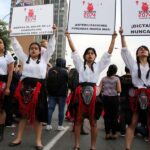Quote:
In the neighbouring village, they invited twenty women from the mothers’ club to donate food and then told them they wanted to vaccinate them. In reality, this was an anaesthetic, after which they were sterilised.
Source:
Schultz, Susanne (2006, in German): Hegemonie, Gouvernementalität, Biomacht. Reproduktive Risiken und die Transformation internationaler Bevölkerungspolitik. Münster: Westfälisches Dampfboot, p. 11.
Author Bio:
Anonymous interviewee, Andean highlands of Peru, interview by Susanne Schultz.
Context:
 Between 1995 and 1998, under the Fujimori government in Peru (1990-2000), around 300,000 women and men were sterilised, especially in poor districts and among the indigenous population. While many women initially used the programme as a means of voluntary sterilisation, it gradually became a coercive measure. International population control programmes have long deployed and continue to deploy various means to try to achieve maximum demographic impact. For example, by sterilising as many women as possible or by inducing them to use contraceptive methods (preferably long-term), be it through "incentives", i.e. gifts via quotas in the health system or, as shown in this quote, through direct coercion and deception.
Between 1995 and 1998, under the Fujimori government in Peru (1990-2000), around 300,000 women and men were sterilised, especially in poor districts and among the indigenous population. While many women initially used the programme as a means of voluntary sterilisation, it gradually became a coercive measure. International population control programmes have long deployed and continue to deploy various means to try to achieve maximum demographic impact. For example, by sterilising as many women as possible or by inducing them to use contraceptive methods (preferably long-term), be it through "incentives", i.e. gifts via quotas in the health system or, as shown in this quote, through direct coercion and deception.Further Reading:
Year:
1998